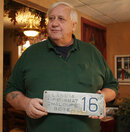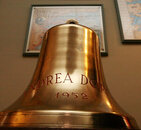Avonthediver
Contributor
It's almost the 2011 dive season in parts of North America. And for some its already here!
So I just wanted to get people going with a little bit of Diving History!
And found this a good read and wanted to share this with the Board so enjoy!
HAPPY 2011 DIVING!
So I just wanted to get people going with a little bit of Diving History!
And found this a good read and wanted to share this with the Board so enjoy!
By ROB JENNINGS
DENVILLEROCKAWAY THIS WEEK
The Andrea Doria sank to the bottom of the Atlantic Ocean more than a half-century ago, but a significant find from the wreckage is now being safeguarded in Rockaway Township.
On July 11, 1985, longtime Rockaway Township resident Art Kirchner, 64, was one of the team of seven divers who recovered a 150-pound bronze bell from the stern of the famed luxury liner.
Kirchner recently drove to Virginia to retrieve the bell from one of his teammates. He explained that the divers take turns with the bell they collectively have ownership and that it will be in his possession for the next six months or so.
He said he is thinking about bringing it to a school perhaps his alma mater, Morris Hills High School, will get to see it up close and personal.
The bell from the Andrea Doria. (Staff photo: Meghan Ryan)
Amomg Kirchner's first stops with the bell, on Jan. 17, was the West Morris Area YMCA in Randolph. His many friends there had heard tales of his diving adventures but had never seen the results of his labors.
The YMCA's chief executive officer, William Lamia, was in his office the afternoon that Kirchner a self-employed electrician who does work at the Randolph Y arrived.
"He came in the back door and said: 'I've got the bell,' " Lamia said.
Welcoming some visitors to his Garrison Avenue home recently, Kirchner said he already had brought it around to the regulars at Murray's Bar in Dover.
While some people object to recovering items from shipwrecks that might be considered graveyards 46 passengers died when the Andrea Doria collided with another vessel Kirchner said he was proud of his role in recovering the bell and other artifacts such as dishes and a lifeboat sign.
"You've got to recover it for history for people to see it," said Kirchner, a grandfather who still occasionally dives.
The sinking of the Andrea Doria on July 25, 1956, is arguably second in luxury liner infamy only to the Titanic. Unlike the Titanic four decades earlier, almost everyone aboard was rescued. A total of 1,660 passengers escaped with their lives; the 46 who died were found near the impact point.
The Andrea Doria was back in the news last June after a New Jersey diver found the ship's fog bell on the ocean floor.
Kirchner was a child when the Andrea Doria sunk. He remembers being transfixed by the disaster, along with the rest of the nation. He could not have known that he would one day dive to the wreckage about 175 feet under water, around 100 miles off Montauk, N.Y. and recover one of its most precious jewels.
Kirchner said that, upon being discharged from the U.S. Army in 1968 he served in Germany but was not sent to Vietnam a friend convinced him to enroll at County College of Morris.
Looking over the class schedule, Kirchner spotted a two-credit course on SCUBA diving that was being offered at the former YMCA in Morristown. He took the class. He loved it. He had discovered, somewhat unexpectedly, what would become a lifelong passion.
He was an experienced diver upon joining the seven-man crew in numerous expeditions to the Andrea Doria, a particularly dangerous wreck to explore.
"It was the wreck to dive to," he said a distinction that, in some cases, has turned tragic.
Kirchner, in his garage, pointed to a 1999 newspaper story about the deaths of two divers among about a dozen who have lost their lives while exploring the ruins.
Kirchner, describing the equipment he was using in 1985, said he had roughly 20 minutes to explore the ship based on the air in his tank. Visibility was so poor, he recalled, that he once nearly became lost.
"You had to look at pieces of the wreck, a little bit at a time," he said.
The bell was found on his 20th and final dive. The seven who recovered the bell, including Kirchner, drew up a contract. They would share ownership, and the bell could be sold only if a majority agreed and for a purchase price of no less than $100,000.
Bill Nagle, who led the expedition on his boat, would receive about half of the proceeds, with the rest shared by the others. Nagle's share passed to his estate upon his 1993 death; the other six survive and take turns safeguarding their prized memento.
While some might argue for keeping the bell safely stashed away, Kirchner said that would be unfair. The bell is meant to be seen, he argued. That was the whole reason for recovering it.
"It's not going to stay somebody's house," he said
HAPPY 2011 DIVING!





